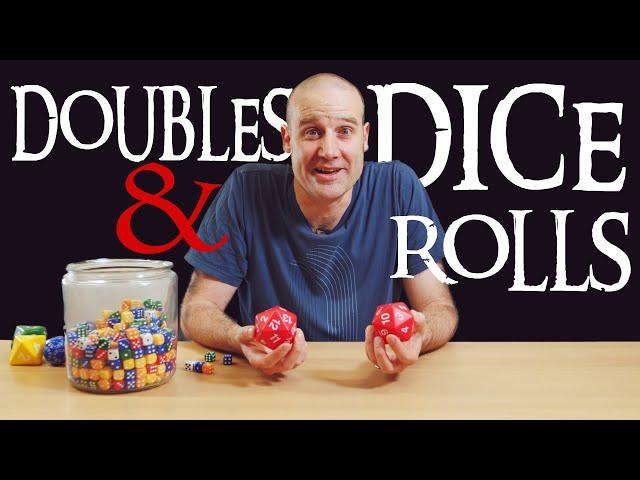
The unexpected logic behind rolling multiple dice and picking the highest.
Комментарии:

This also works in reverse for DISADVANTAGE, so in that case, there's a 0.25% chance of rolling 20, and it goes up by 0.50% for each number you subtract from 20, so 0.75 for 19, 1.25% for 18, 1.75% for 17 and so on and so forth till your chances of rolling a 1 is 9.75%.
Ответить
A common thing in D&D for stats is to roll 4 d6 and drop the lowest, might be a fun sequel to this video
Ответить
Be honest Matt, do you have a jar of D6 dices in your offices just hoping for the day someone mistakes them for D6-shaped candy?
Ответить
If they taught maths like this in school it would have been my favourite subject
Ответить
I know little of math. Why squared instead of cubed? Dice are cubes. Not flat squares.
I know it's probably an idiot question. But, again, I am a math idiot. So it all works in the end.
Edit: I think it's because what's being measured/calculated are each individual square and not the entire die.

I enjoyed the part were he looked like he was seriously considering gluing dice together in 4 dimensions 😄
Ответить
Everything well until minute 23... moment at wich my brain melted.
Ответить
What is the math for picking the lowest; I.e. rolling at disadvantage?
Ответить
In case you needed math for the worst edition
Ответить
I love the visualization of the maths :D :D
Ответить
Combinatorics
Ответить
Came here after attacking a prone enemy as a fighter with action surge. I got 4 nat 1s back to back
Ответить
Ok, bit of an odd question, how often would an advantaged d12 beat a disadvantaged d20?
Backstory on this, I’m homebrewing a campaign, and all the spells are rolled with d12s, now I have this spell for the technique skill tree where the caster rolls advantaged d12s to predict the targets movements and critically strike, and the target rolls disadvantaged d20s to dodge.

Something worth mentioning: the fraction you came up with represents the portion of the difference between maximum and minimum. So, it's not just that dice aren't infinitely sided, it's also that it starts at 1 rather than zero.
The number of times larger the maximum is relative to the minimum dictates how close to the potential theoretical maximum possible value you gain from extra trials is dictated by this relationship. If the bottom number is 0, then it achieves maximum value. This is why a d20 roll gets more value than a d6 from advantage.
A nice way to visualize this is to imagine a number line. The minimum is the start of the line and maximum is the end. To find the average, you split the number line in two (right down the middle point between min and max) and that point represents the average for a single roll. With two roll, you split the line in thirds and choose the highest point you marked (2/3 of the way from min to max). This works on and on like you described (e.g. 10 rolls would be 10/11 of the way up that line).

This makes it funny to me, because when using Passive scores (such as Perception or Insight) in D&D, the Dungeon Master's Guide says to just add or subtract 5 to emulate advantage or disadvantage since you don't roll for your passive ability scores. Meaning, you're effectively assuming the fabled "triple" advantage (which only really exists with the Elven Accuracy feat). Interesting and funny to think about from a math perspective rather than a game perspective.
Ответить
Relating to D&D advantage, when you generate ability scores (1-18) a common way to generate them is to roll 4D6 and drop the lowest (3-18). I'm pretty sure after this that I can work out the math now, but it might be neat to see you do a vid on this and see what interesting things fall out when you tweak the question as you did here.
Ответить
New house rule: roll your damage die with advantage + max weapon damage.
Example: d&d 5e longsword used 1h (d8). Crit = 8 + (adv d8 roll) + str mod.
Crits are supposed to be... critical. They are the types of rolls that are supposed to feel awesome. Why not make them actually FEEL awesome?
Edit: max weapon damage for each multiplier - 1... if the crit is x3, then max weapon damage x2... if crit is x4 then max weapon damage x3.

Esse cara tem dado em casa
Ответить
that +0.5 at the end doesn't convince me, if you did this with 200d20 the average result would then be 20(200/201) + 0.5 but it's 20.4 and it shouldn't be more than 20. must be that the 0.5 also gets reduced somehow the more dice you roll but I wonder how exactly
I calculated it for a 2d20 roll, it's actually +59/120 in the end, not +1/2, and for a generic n-sided die it seems to be +(1/2-1/6n) but still no idea how it works or how it goes on for rolling three or more dice

how come I pay attention to this but not my math lectures
Ответить
What is the maths for character creation: rolling 4d6 and removing the lowest?
Ответить
(Variables:
n=number of sides on single di
x=percent of max
y=number of dice rolled)
Happy to be proven wrong, I truly am because nothing delights me more than to learn that I have more to learn! But the numbers don’t seem right to me. Here’s the numbers I crunched:
(n+1)/n does not equal 1 [it equals 1+(1/n)]. While you are overall correct about the convergence of the formula to 1 for infinite limit n values, here we in fact have a limit of n that is significant to this equation and has not significantly converged towards 1 by this point. Thus, 1+(1/n) holds significance still.
For the exact same reason, (4n-1)/n does not equal 4 [it equals 4-(1/n)].
As such, the solution is not “exactly 2/3”. It is close, but not exact - and in math I think it’s extremely important to clarify between “exactly” a value and “approximately” (or more accurately in this case, “converging to”) a value.
For larger limit values of n, I agree that it will eventually converge to a point of insignificance. But the current value of n (20) is still within the realm of mathematical significance.
You can confirm this with a simple percentage check. You already confirmed the average is 13.825 for advantage rolls. 13.825/20=0.69125, not 0.66667 (or 2/3). This is true even if you divide the exact numerical average of all 400 possible rolls (5,530) by the exact numerical max value of 400 possible rolls (8,000). Some commenters mentioned that some quirks of the math are due to values being between 1 and 20, but I wanted to show that this wasn’t the case for this particular point.
The exact correct formula should be (1/6)(1+[1/n])(4-[1/n]). Err, (1/[6n^2])(n+1)(4n-1) makes more sense in my brain, but they equal the same thing so I’ll stick with what you wrote up. Double-checking this:
Average value of d20 advantage rolls: 13.825 (I agree with the math through this point of the video)
Percentage of average value versus max value: 13.825/20=0.69125 (not 0.6667)
Now let’s plug n=20 into my proposed corrected formula:
(1/6)(1+[1/20])(4-[1/20])=x
(0.16667)(1.05)(3.95)=x
0.69125=x
In short: while the formula converges closer and closer to y/(y+1) for larger and larger values of n, it is not equal to it! It remains significant for the values of n we are using.

Super late to the party. Its not (+1/2) its (+1/n)
Ответить
So what you're really saying is that we can use dnd to calculate higher dimensional properties
Ответить
starts gluing dice in four dimensions
Ответить
See, I thought the question we were looking for was "on average, how better is rolling with advantage over rolling without"
Ответить
if you take ability modifiers (+-X) into consideration you can easily calculate the probablities of success or failure on each given dice roll in dnd whether or not it's done with advantage, disadvantage or neither of those. this should also explain how Baldur's Gate 3 calculates the success rates of your spells/attacks in combat. It's nothing more than the game comparing your expected result (your average roll + any applicable modifier/conditions such as advantage) to the number (for example an opponents armor class) you need to match/exceed or in case of an opponent needing to succeed a saving throw it's the other way around (the probability of the opponents roll being lower than the difficulty class of the saving throw imposed on them). I will now proceed to send this to my playgroup. awesome video.
Ответить
Two thoughts:
Say you have n randomly distributed variables from 0 to 1. By symmetry, the distances between these values will be identical, so what you expect to happen is that the variables will space themselves in intervals of 1/n (1/n, 2/n… (n-1)/n). In the case of 2 variables, you get 1/3 and 2/3. Then the maximum expected value of n random variables is (n-1)/n, which immediately gets you your limit in the video.
Second, the extra “.5” stems from the fact that dice cannot role zero, so the 2/3 is not 2/3 of 20 but more like 2/3 of the way between 1 and 20 (not exactly because it’s not continuous).

What about rolling 4d6 and taking the three highest?
Ответить
Conclusion: Elven Accuracy is OP
Ответить
The most interesting issue with the final equation for the average from m rolls is that if you could roll the dice an infinite amount of times, you would average n + .5, which is more than the number of sides allows
Ответить
When you generate a character's stats, the average value is 12.3. You roll 4 dice and total the three highest. So, the expected value of the highest die is 4/5s, and assuming the value of lowest die is 1/5, or 1.2. Common sense dictates that you still add the half, to get you an expected die value of 1.7 for the lowest of four dice. So (3.5 times 4) - 1.7 = 12.3.
Ответить
Why did you take the rhombic dodecahedron away? I was so mesmerized by it. And then you just tucked it under the table!
Ответить
Was this guy on numberphile?
Ответить
I like how you have a d120! I really like The Dice Lab's dice, and I'm glad you supported them!
Ответить
This smells of Bernoulli numbers.
Ответить
Here is another question... What die can multiple people roll simultaneously (and get different but fair results)?
Ответить
Commenting late but I want to say that in high school I read Things to Make and Do in the Fourth Dimension and really liked the section on Bernoulli numbers, so I wrote a paper on it. My paper included this exact problem (with choosing the minimum value, but it’s the same math). Very cool to see this in a Matt Parker video
Ответить
Great maths video but... maths is only a third of your channel
Ответить
I was trying to think of a way to word this, and im not sure this is it, but How likely are you to still roll a 1 if you have advantage as you move towards infinite dice and rolls? (Still be forced to take a 1 by all 1s being rolled I mean)
Ответить
Thinking about dice, i always struggle with the fact, that there is no 0
It's from 1-6 rather than 0-6
Why is the average 3 and not 3.5
I threw 10000 d6 in an Simulator and the result was 35049, so 3.5 on average. I did the same with an d4 and the average was 2.5 so, is this an coincidence or am i getting something wrong?

The singular of "dice" is "die". All of this "a dice" nonsense is driving me up the wall.
Ответить
This seemed intuitive to me and it took me a minute to understand why it made sense. I think I finally put it together. This might be a very simplistic way of looking at it and may prove nothing. If your average for a single die is always the middle value, then you could say you have a 1/2 chance of rolling above or below that. Now rolling 2 dice means you have two 1/2 chances. So... much like what you already did you could chart your graphs.
Above avg
|
|
Below avg-------- Above avg
It would seem you have a 2/3 chance of being above average and I guess the average value correlates. Thankfully, you showed it works. The same continues in three dimensions, you get one instance of all dice being below avg and three instances of at least one die being above for 3/4.This might be a very simplistic way of looking at it and may prove nothing.

So, clearly that's too big of an advantage for my sadistic game... What if i give them their standard 20 sided die, but only a second 12 sided die? 😝
Or a 20, 12 and 6 set of dice? 😄


























